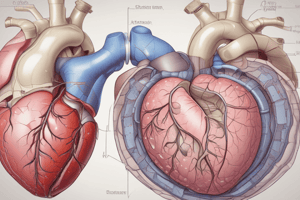Podcast
Questions and Answers
What is the most common cause of mitral stenosis?
What is the most common cause of mitral stenosis?
- Pulmonary hypertension
- Age-related calcification
- Rheumatic fever (correct)
- Congenital heart defects
Which symptom is commonly associated with mitral stenosis?
Which symptom is commonly associated with mitral stenosis?
- Shortness of breath with exertion (correct)
- Severe headache
- Dizziness upon standing
- Nausea and vomiting
What is a key diagnostic tool for mitral stenosis?
What is a key diagnostic tool for mitral stenosis?
- MRI
- Blood test
- Echocardiogram (correct)
- CT scan
Which complication is associated with mitral stenosis?
Which complication is associated with mitral stenosis?
What type of procedure is balloon valvuloplasty?
What type of procedure is balloon valvuloplasty?
Flashcards
Mitral Stenosis
Mitral Stenosis
Narrowing of the mitral valve, impeding blood flow from the left atrium to the left ventricle.
Causes of Mitral Stenosis
Causes of Mitral Stenosis
Most commonly caused by rheumatic fever, also congenital defects or age-related calcification.
Symptoms of Mitral Stenosis
Symptoms of Mitral Stenosis
Shortness of breath, fatigue, palpitations, chest pain, and swelling in legs/feet.
Diagnosing Mitral Stenosis
Diagnosing Mitral Stenosis
Signup and view all the flashcards
Treatments for Mitral Stenosis
Treatments for Mitral Stenosis
Signup and view all the flashcards
Study Notes
Mitral Stenosis
-
Definition: Mitral stenosis is a heart valve disorder characterized by narrowing of the mitral valve opening, impeding blood flow from the left atrium to the left ventricle.
-
Causes:
- Rheumatic fever (most common cause)
- Congenital heart defects
- Age-related calcification
- Other rare conditions (e.g., tumors)
-
Symptoms:
- Shortness of breath (especially with exertion)
- Fatigue
- Palpitations (due to atrial fibrillation)
- Chest pain
- Swelling in legs or feet
-
Diagnosis:
- Physical examination (murmur during auscultation)
- Echocardiogram (key diagnostic tool)
- Chest X-ray (may show left atrial enlargement)
- Electrocardiogram (ECG) (to assess rhythm and heart function)
-
Complications:
- Atrial fibrillation
- Pulmonary hypertension
- Heart failure
- Thromboembolism (increased risk for stroke)
-
Treatment Options:
- Medications: Diuretics, beta-blockers, anticoagulants
- Procedures:
- Balloon valvuloplasty (minimally invasive)
- Mitral valve replacement (surgical intervention)
-
Prognosis:
- Varies based on severity and treatment
- Early detection and management can improve outcomes significantly.
Mitral Stenosis
- Mitral stenosis is a heart valve disorder.
- The mitral valve is located between the left atrium and left ventricle.
- The disorder obstructs blood flow between these chambers.
- The primary cause of mitral stenosis is rheumatic fever.
- Other causes include congenital heart defects and age-related calcification.
- Common symptoms include shortness of breath, fatigue, and palpitations.
- Diagnosis is confirmed through echocardiogram.
- Chest X-ray and electrocardiogram are used to assess heart function and rhythm.
- Complications include atrial fibrillation, pulmonary hypertension, heart failure, and thromboembolism.
- Treatment involves medications like diuretics and beta-blockers.
- Procedural options include balloon valvuloplasty and mitral valve replacement.
- Prognosis depends on the severity of the condition and the effectiveness of treatment.
- Early detection and management lead to improved outcomes.
Studying That Suits You
Use AI to generate personalized quizzes and flashcards to suit your learning preferences.




